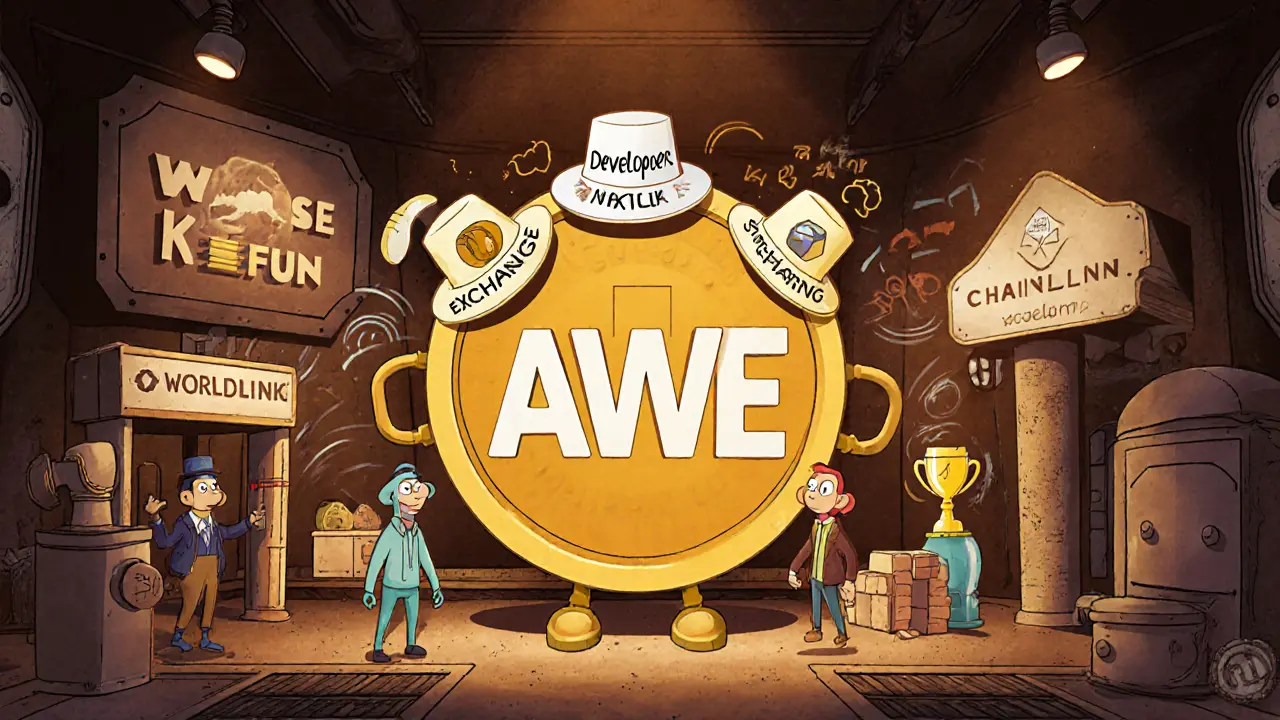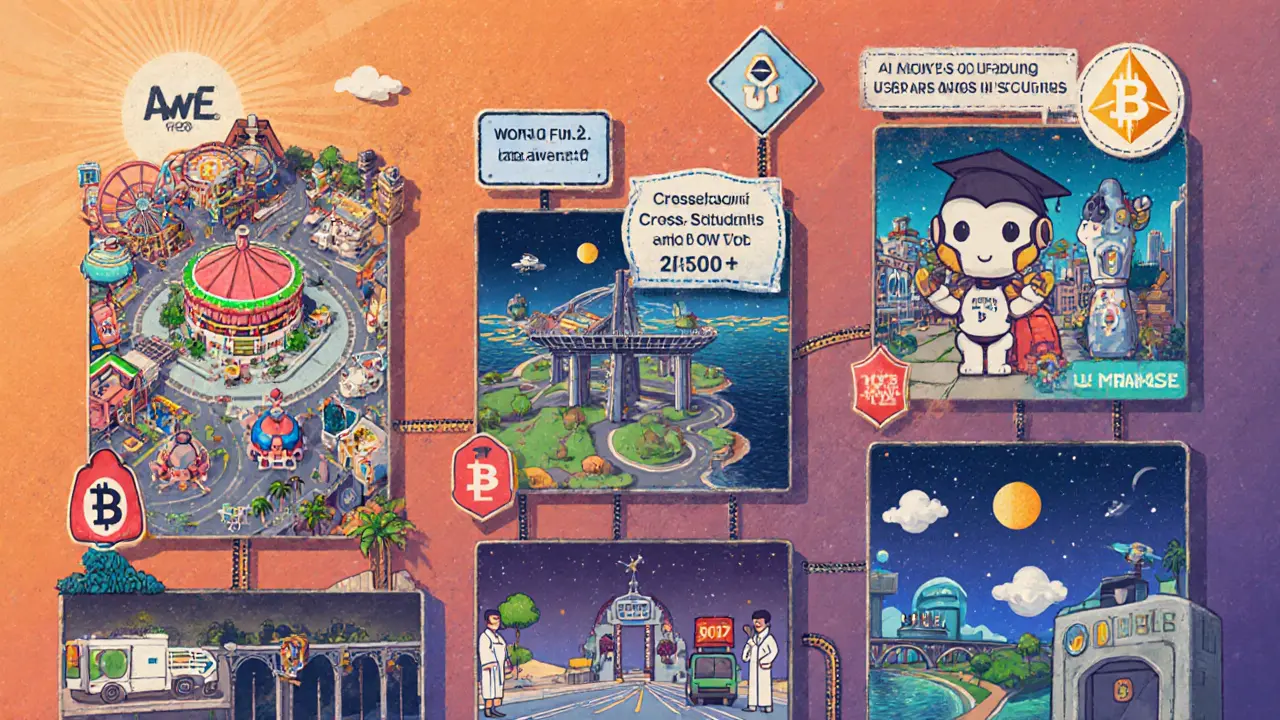AWE Staking Reward Calculator
Calculate your potential rewards when staking AWE tokens. Note: Actual rewards may vary based on network activity and market conditions.
Staking Parameters
- Changing transaction volumes
- Network fee fluctuations
- Token supply changes
What is AWE (AWE) and why does it matter?
When you hear the name AWE Network is a blockchain platform built for Autonomous Worlds - persistent, AI‑driven environments where thousands of agents can interact, learn and evolve. The native coin, AWE token, powers every transaction, governance vote and reward inside these worlds. In plain English, AWE lets developers create self‑running simulations that live on the blockchain, and the token is the fuel that keeps the whole system running.
From STP Network to AWE: a quick history
Back in 2019 the project launched as STP Network, a governance‑focused chain. By 2023 the team realized that AI agents were the next big thing and completely pivoted. The rebrand to AWE Network came with a new ticker - AWE crypto - and a move to the Base blockchain, an Ethereum Layer 2 solution that offers cheap, fast transactions. The shift gave the project a clear niche: building the world’s first scalable platform dedicated solely to Autonomous Worlds.
How the AWE token powers the ecosystem
The token wears four hats at once:
- Governance: holders vote on protocol upgrades, fee structures and new world standards.
- Medium of exchange: AI agents pay each other for resources, and users pay for in‑world items or services.
- Staking: locking AWE helps secure the network and earns a share of transaction fees.
- Rewards: developers, researchers and active participants receive AWE for contributing valuable simulations.
All of these actions are recorded on the Base chain, which means every swap, vote or reward is transparent and immutable.
Technical foundation - the Autonomous Worlds Engine
The core of the platform is the Autonomous Worlds Engine, a modular framework that lets developers spin up persistent AI simulations at scale. The engine talks to three key components:
- World.Fun: a discovery marketplace where creators list their worlds and users can explore them.
- Chainlink oracles: they feed real‑world data (weather, market prices, etc.) into the simulations.
- Base blockchain: provides the Layer 2 scalability that keeps gas fees low while still inheriting Ethereum’s security.
Because the engine runs on a Layer 2, it can handle thousands of agent interactions per second, something that would be prohibitively expensive on Ethereum’s mainnet.

Real‑world use cases
Think of a climate‑modeling project that needs to run millions of tiny calculations and keep every step auditable. Researchers at Stanford have already used AWE to run a multi‑agent climate simulation that persisted across thousands of blocks. Another example is a virtual economy where AI merchants negotiate prices, adjust supply and react to player demand - all without a central server.
These cases share a common thread: they require persistent state, transparent verification and the ability for many autonomous agents to act simultaneously. Traditional blockchains can store data, but they lack the built‑in AI orchestration that AWE provides.
Market snapshot (as of September 2024)
Here’s a quick look at the numbers that matter:
| Metric | Value |
|---|---|
| Market cap | $144 million |
| Circulating supply | 1.94 billion AWE |
| Total supply | 2 billion AWE |
| 24‑hr volume range | $25 million - $186 million |
| Rank by market cap | #357 (TradingView) |
Liquidity is decent, with over 140 active trading pairs across major exchanges like Binance, Coinbase and several decentralized venues on Base. Price volatility is higher than Bitcoin or Ethereum, reflecting the project’s early‑stage nature and niche focus.
Risks, criticisms and what to watch
Analysts are split. Some, like Marcus Chen at Gate.io, see AWE as a “potentially transformative” bridge between AI and blockchain. Others warn that the technology is still chasing a moving target - the AI‑agent standards aren’t set, and scaling many agents on-chain is a hard problem.
Key risk factors include:
- Technical complexity: developers need both Solidity (or a similar language) and AI‑agent expertise, which limits the pool of contributors.
- Regulatory unknowns: autonomous agents that generate economic value could attract scrutiny from the SEC or the EU’s MiCA framework.
- Adoption hurdle: casual investors often struggle to see real‑world value beyond speculative price moves.
Keep an eye on roadmap milestones - successful launches of cross‑chain interoperability or advanced learning protocols could boost confidence.

Getting started - a simple checklist
If you want to dip your toes in the AWE pool, follow these steps:
- Set up a Base‑compatible wallet (e.g., MetaMask configured for the Base network).
- Buy AWE on a supported exchange - Binance, Coinbase, or a Base DEX such as BaseSwap.
- Transfer the tokens to your wallet and lock them if you plan to stake.
- Visit World.Fun to explore existing worlds or start building your own.
- Read the official GitHub repository (awenetwork/awe-core) for developer tutorials and sample code.
Non‑developers can still participate by voting in governance polls or simply holding AWE to earn staking rewards.
Future roadmap - where AWE is headed
The team has an aggressive plan:
- Q4 2024: launch of World.Fun 2.0 with better UI and new agent‑to‑agent communication tools.
- Q1 2025: rollout of advanced learning protocols that let agents improve over time without external training.
- Q3 2025: Mainnet 2.0 upgrade enabling cross‑chain agent interactions (Ethereum, Polygon, Solana).
- 2026 onward: partnerships with research institutes and commercial firms to run large‑scale simulations (energy grids, supply‑chain logistics, etc.).
Each milestone aims to reduce the technical barrier and widen the pool of participants, which could translate into higher token demand.
Bottom line
AWE sits at the intersection of two fast‑growing fields: AI and blockchain. If you like building complex simulations or you’re an investor looking for a project that targets a future where autonomous agents run on a public ledger, AWE is worth a deeper look. Just remember the learning curve is steep, the price can swing wildly, and regulatory clarity is still coming.
What does the AWE token actually do?
AWE is used for governance voting, paying AI agents, staking to secure the network and rewarding developers or researchers who contribute valuable simulations.
How can I buy AWE?
AWE is listed on Binance, Coinbase and several Base‑based DEXes. Set up a Base‑compatible wallet, purchase the token on an exchange, then transfer it to your wallet.
Do I need AI knowledge to use AWE?
You don’t need to be an AI expert to hold or stake AWE, but building your own Autonomous World does require familiarity with AI‑agent frameworks and basic Solidity coding.
What are the biggest risks for AWE investors?
Technical complexity, regulatory uncertainty, and limited mainstream adoption are the main concerns. Price volatility adds an extra layer of risk.
When is the next major upgrade expected?
The roadmap lists a Mainnet 2.0 upgrade for Q3 2025, which will bring cross‑chain agent support and performance boosts.


Scott McCalman
October 22, 2025 AT 03:21Alright, so AWE basically tries to turn every AI agent into a blockchain micro‑service. Imagine a Swarm of bots trading pastries on a Layer‑2 ledger – that’s the vibe. The token is doing double‑duty: paying gas and acting as governance juice. If you’re not into that, you’ll probably miss the point. 🤔
PRIYA KUMARI
October 28, 2025 AT 14:55The whole thing reads like a vaporware brochure written by marketers who never built anything. AWE’s hype machine is pumping tokenomics while the actual SDK is still a half‑finished experiment. You’d be better off staking your patience elsewhere. This is not innovation, it’s a buzzword salad.
Jessica Pence
November 4, 2025 AT 02:28If you’re looking to get your feet wet, start by setting up a MetaMask on the Base network – it’s pretty straight‑forward. Grab some AWE on Binance, then move it to your wallet before you try any steking. The governance UI can be a bit clunky, but the docs have step‑by‑step screenshots. Also, keep an eye on the World.Fun updates, they drop new worlds weekly.
johnny garcia
November 10, 2025 AT 14:01Contemplating the convergence of autonomous agents and immutable ledgers invites us to question the very nature of agency. When a token becomes the lifeblood of a virtual ecosystem, we are watching economics mutate into a self‑referential simulation. One could argue that AWE is a digital embodiment of Leibniz’s monads, each agent reflecting the whole through its interactions. Yet the underlying code remains susceptible to the same bugs that plague traditional smart contracts. In this light, the token is both a catalyst and a containment vessel for emergent complexity. 🌌
Andrew Smith
November 17, 2025 AT 01:35I get why people are skeptical, but the roadmap looks solid and the community is actually building things now. Staking rewards are already flowing, so early adopters can see real upside. This kind of grassroots momentum often signals a project worth watching.